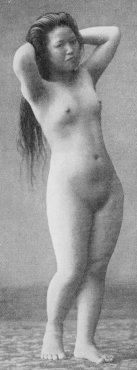|
One of the most important, but often overlooked anthropometric features, is relative trunk length. It is particularly useful when comparing African groups or populations on a global scale. It is synonymous with relative leg length and sitting height, and is measured by the cormic or scelic index.
On the population level, sitting height varies from 45 to 56 percent of standing height. The length of the legs often contributes more to height than trunk length itself. Thus, the smallest humans, the short-legged African Pygmies, have trunks only slightly shorter than their long-legged Nilotic neighbours.
The cormic index is often more useful to determine the racial group than is the much more prominent skin colour. Mongoloids usually show relatively short legs, Caucasoids, Americanids, and Capoids legs of medium length, and Negroids as well as Australoids long legs - apart from Pygmies.
Relative trunk length seems to be one of the primary human adaptions. It developed during the Paleolithic as response to climate conditions. In cold climate, short limbs and large bodies are favourable, in hot climates sweating is more efficient in long lean bodies with long limbs (Allen's rule).
Later during the Neolithic, when humans used clothing, trunk length hardly continued to change - in difference to many other anthropometric traits. On this site, five categories of relative trunk length are used: hypermacroskelic (very great relative trunk length, very short relative leg length), macroskelic (great relative trunk length, relatively short legs), mesoskelic (average relative trunk length, legs of medium length), brachyskelic (short relative trunk length, legs of long length), hyperbrachyskelic (very short relative trunk length, very long legs).
|









